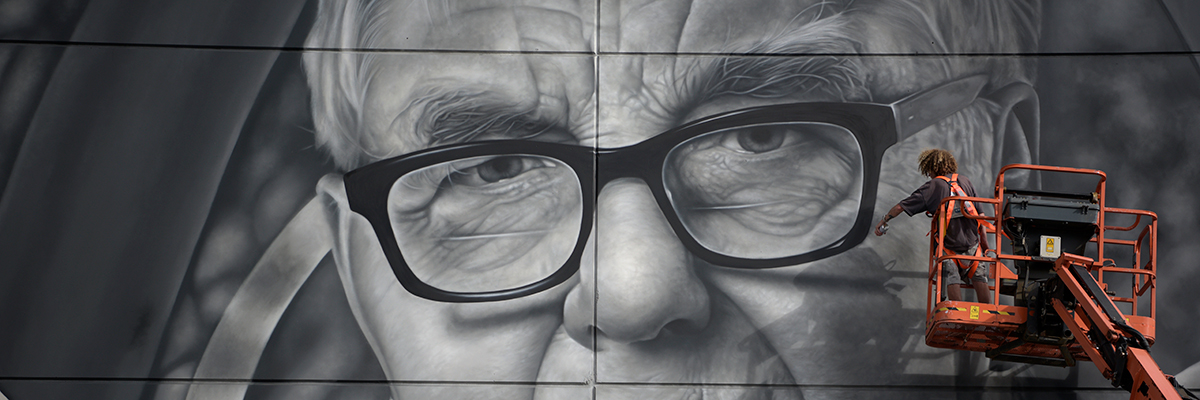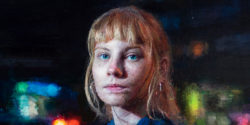In Auckland, New Zealand, a new mural emerges from the city’s urban landscape, capturing one essence of New Zealand’s artistic evolution. “Anima,” a striking creation by Owen Dippie, a prominent New Zealand street artist, is a profound tribute to fellow artist Max Gimblett. Nestled in a rugged part of the city, this mural stands as a confluence of artistic expressions and shared histories, bridging the traditional with the contemporary.

Owen Dippie, acclaimed for his large-scale, photorealistic portraits, has many times showcased his exceptional skill in honoring iconic figures of the art world and community figures who have impacted people’s history. Selecting Max Gimblett as his subject, Dippie acknowledges Gimblett’s notable influence in art and himself. Both artists share a deep connection with New York, a city that has significantly shaped their artistic journeys despite their New Zealand origins.
The mural, a monochromatic portrayal of Gimblett, is encased within the quatrefoil shape, a signature element in Gimblett’s art. This shape, reminiscent of a four-leaf clover, carries deep symbolic meanings across different cultures and religions, from representing the four evangelists in Christianity to embodying symmetry and order in Islamic art.

In Gimblett’s artistic universe, probably influenced by his Rinzai Zen monk practices and spiritual quests, the quatrefoil symbolizes the harmonious amalgamation of Eastern and Western art philosophies. His work further accentuates this blend, often marrying Abstract Expressionism and Modernism with Asian calligraphy’s spiritual abstraction. Presented in collaboration with Gow Langsford Gallery, “Anima” can also be seen as a dialogue between Dippie’s and Gimblett’s artistic ideologies, known for challenging conventional art forms and blending tradition with innovation.
Max Gimblett’s journey from Auckland to the global stage is marked by his extensive travels, teaching experiences, and exhibitions worldwide. His artworks, characterized by masterful brushwork, a sophisticated color palette, and glossy surfaces enriched with gilding, reflect a diverse range of influences — from the alchemical mysteries and the Presbyterian Church of Scotland of his upbringing to the aesthetics of Japanese lacquerware and temple art. Gimblett’s unique artistic language is celebrated in significant museum collections globally, including the Guggenheim Museum, the Museum of Modern Art, and the Whitney Museum of American Art.

Other Articles You May Like from BSA:
Welcome to BSA Images of the Week. It's been snowing and snowing and snowing this month in New York - providing perfect framing for graffiti and street art. Here's our weekly interview with th...
We like you to have books, even though BSA is almost exclusively a digital companion for our readers and fans. But yes, we are in love with books and Christmas is coming and so is Hannukah in 5 days o...
Yesterday our posting was about artists in London creating works about endangered species and today we go to Barcelona where 35 artists joined with Greenpeace and a local group named RebobinArt on Apr...
“The artwork invites us to think about the lack of empathy we demonstrate towards the rest of the species and to the action/reaction process that ensues”, says street artist and muralist Gola Hundun...
Did you see the blue moon over New York Friday night? Looked to be more crimson actually. Welcome to August and the hot sticky band of dirty grit that comes with it. Escape from New York if you ...
 BROOKLYN STREET ART LOVES YOU MORE EVERY DAY
BROOKLYN STREET ART LOVES YOU MORE EVERY DAY










